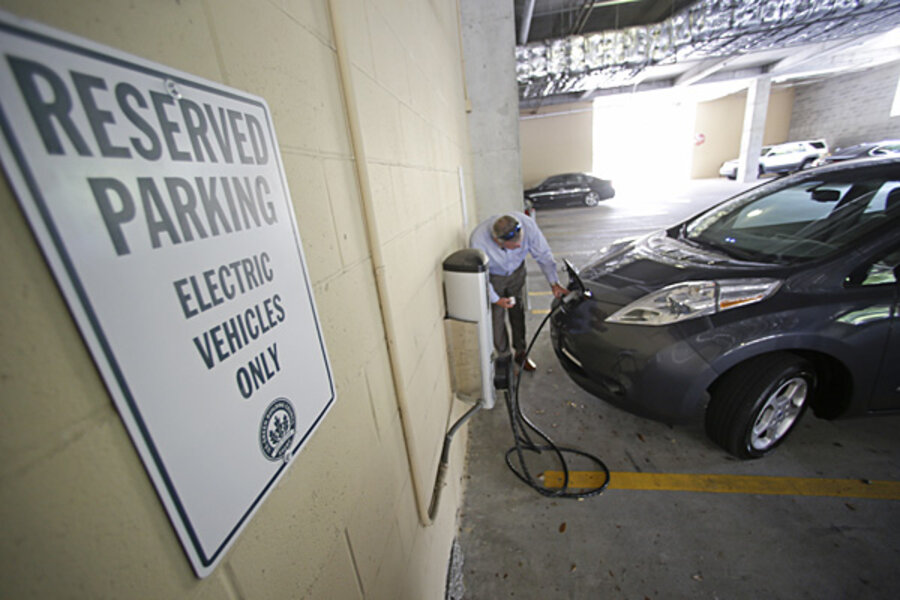Can DOE build a better electric car battery?
Before its annual Energy Innovation Summit in 2013, the Department of Energy’s Advanced Research Projects Agency-Energy (ARPA-E) announced funding for a new program aimed at rethinking electric vehicle (EV) batteries. The program, Robust Affordable Next Generation Energy Storage Systems or RANGE, was created as part of an integrated effort to accelerate electric vehicle innovation to reduce costs and improve performance of EVs. Last week, ARPA-E announced the names and descriptions of the 22 recipients for the RANGE program, representing fresh approaches to making EVs available to everyone.
ARPA-E has invested in transportation technologies since its creation. The new RANGE program complements the agency’s BEEST program for doubling the energy density of EV batteries by altering battery composition and materials, AMPED for seeking advanced power management technologies for storage, and GRIDS, for developing cheap utility scale storage. The RANGE program is a genuine reflection of these previous ARPA-E’s programs as it supports truly far-reaching innovations and revolutionary energy technologies.
The program recognizes that significant breakthroughs in battery chemistry and vehicle architecture are crucial for EVs to compete with internal combustion vehicles. In response, most of the RANGE projects consider alternative materials for batteries that are lighter than existing batteries, safer in the case of collision, and don’t rely on foreign-sourced rare materials. We spoke with Dr. Cheryl Martin, Deputy Director of ARPA-E, about the new program, which she described as the agency’s “twist on improving the EV battery space.”
Why EV Battery and Vehicle Design Matters
The battery system is the most complex and expensive element of an EV, which means innovations in its size, material, structure, and placement are integral to making EVs affordable and reliable enough for every American to replace their conventional combustion vehicles.
The RANGE program facilitates what Dr. Martin calls these kinds of “big swing” innovations by investing in a variety of projects that address key system challenges, but approach solving these problems from different directions. The program invests in “seedling” early-stage projects – like the collaborative project between EnZinc, Inc. and the U.S. Naval Research Lab funded at only $448,000. According to EnZinc’s president and co-founder, Michael Burz, “What we knew was needed is a systems approach to battery design – a reimagining of the fundamental architecture of the battery. Where most battery development uses exotic materials in a fundamentally conventional way, we are using conventional materials in an exotic architecture.” EnZinc’s zinc-air battery has the potential to double range and cut costs in half, which according to Dr. Martin could prompt a “technology leap that could be absolutely important for the future of EVs.”
On the other end of the spectrum, four of the funded projects in the RANGE program focus on integrating EV batteries into the vehicle structure itself, which could reduce vehicle weight, increase driving range, and strengthen safety standards. One such project run by UC San Diego, funded at $3.49 million, is developing EV batteries as part of the vehicle’s support structure, which will be incorporated into a redesign of the standard vehicle frame. The principle investigator on the project, Professor Yu Qiao commented, “According to our analysis, if low-cost, relatively-high-energy batteries can be robust and multifunctional with the vehicle structure redesigned, drive range can be increased to 250-300 miles at an affordable price.” The project’s work focuses on creating batteries that can continue to operate safely and efficiently under adverse conditions, in addition to improving EV cost and performance.
Dr. Martin noted that “these formable batteries can potentially be placed in many different spaces in the car or distributed throughout the frame,” which would allow EV batteries to operate not as a separate technical system from the rest of the vehicle, but as a single but multifunctional technology. As limited driving range continues to be a significant strike against existing EVs, these transformative projects that rethink vehicle “architecture” to decrease vehicle weight and increase range could be adopted by industry in the near-term.
Getting EVs Cheaper than Combustion Engine Vehicles
ITIF noted in its 2012 report, Shifting Gears: Transcending Conventional Economic Doctrines to Develop Better Electric Vehicle Batteries, that electric vehicles still lag far behind conventional vehicles in reliability and continue to be prohibitively expensive for most car-buying Americans. Until EVs can match the cost and performance of conventional gas vehicles, widespread deployment is unrealistic. Consistent and substantial investment in battery system innovation is necessary to address the remaining economic and technical challenges facing EVs.
The RANGE projects represent public investment in energy innovation at its best and could improve battery life, system design, and cost. As Mr. Burz also noted, “The role of ARPA-E in our technology’s development will be significant. They recognized the game-changing aspect of the technology and were willing to take a risk where the commercial investment community would not…The economy of innovation is by necessity risky because that is where the possibility of great gains lies.”
These revolutionary approaches to designing electric vehicles enable the possibility of “drop-in” replacements for conventional gas vehicles in the future. The RANGE program is another strong example of the inspired and bold mission of ARPA-E to identify and address areas of technical weakness within the energy ecosystem through effective investments in ground-breaking projects.






